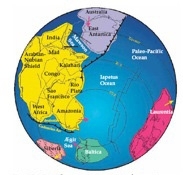The early paelozoic major expansions and extinctions
The Early Paleozoic: Major Expansions and Extinctions
| Topics: |
Photosynthetic organisms, which had somehow escaped extinction during the severe glaciation of the Cryogenian, proliferated, and atmospheric O2 concentrations climbed to about 15%. [1] Multicellular organisms appeared. Again, this was not a coincidence. At higher O2 concentrations, parts of organisms could be situated deeper within the organism and still receive sufficient O2 to conduct aerobic respiration. [2] Also, the thicker ozone (O3) layer in the upper atmosphere afforded greater UV protection, so organisms could complete longer life cycles (a development analogous to rise of the ozone layer in the upper atmosphere during the Great Oxidation Event mentioned earlier in the chapter).
A rapid expansion of biological diversity known as the Cambrian Explosion becomes evident in the fossil could be situated deeper within the organism and still receive sufficient O2 to conduct aerobic respiration. [2] Also, the thicker ozone (O3) layer in the upper atmosphere afforded greater UV protection, so organisms could complete longer lifecycles. A rapid expansion of biological diversity known as the Cambrian Explosion becomes evident in the fossil record at about 0.54 Ga. More than 900 animal species, including representatives of all modern animal phyla, appear. [3] Earlier life forms may have been equally diverse, but they were soft-bodied and seldom left their mark in the fossil record. In contrast, Cambrian animals had shells or other hard body parts that left a stronger impression, and thereby these animals are better preserved as fossils in the rock.
A supercontinent, Gondwana, coalesced during the Cambrian period. This continent included the landmasses that comprise all the continents of today's Southern Hemisphere (Antarctica, South America, Africa, Madagascar, Australia–New Guinea, and New Zealand), plus two continents of today’s Northern Hemisphere (Arabia and India). As the Cambrian was ending, at about 0.51 Ga, Gondwana began to drift southward toward the South Pole.
The Ordovician–Silurian Extinction Event
Devastating mass extinctions occurred during the late Ordovician, at about 0.44 Ga. [4] All major life forms were affected. Approximately 85% of the species previously found in the fossil record disappeared.
The primary cause appears to be a brief glacial interval. Ice began to accumulate on the polar areas of Gondwana as the supercontinent slid southward. This initiated falling sea levels, a higher global albedo, cooler temperatures, and glaciation.
Geologists have postulated several additional contributing factors for the scale of the extinctions. One is that the sea-level decline was large, on the order of 50 meters to 100 meters. This would have drained the shallow seas that extended into the interior of land masses, resulting in a harsh climate at low and mid-latitudes. Low sea levels also could have activated deep ocean currents that aerated the seabed and brought up toxic materials from the depths.
[1] Berner, R. A. (2003) The long-term carbon cycle, fossil fuels and atmospheric composition. Nature 426:323-326.
[2] Budd, G. E. and S. Jensen (2000) A critical reappraisal of the fossil record of the bilaterian phyla. Biological Reviews 75:253-295.
[3] Marshall, C. R. (2006) Explaining the Cambrian "explosion" of animals. Annual Review of Earth and Planetary Sciences 34:355-384.
[4] Sheehan, P. M. (2001) The Late Ordovician mass extinction. Annual Review of Earth and Planetary Sciences 29:331-364.
This is an excerpt from the book Global Climate Change: Convergence of Disciplines by Dr. Arnold J. Bloom and taken from UCVerse of the University of California.
©2010 Sinauer Associates and UC Regents
